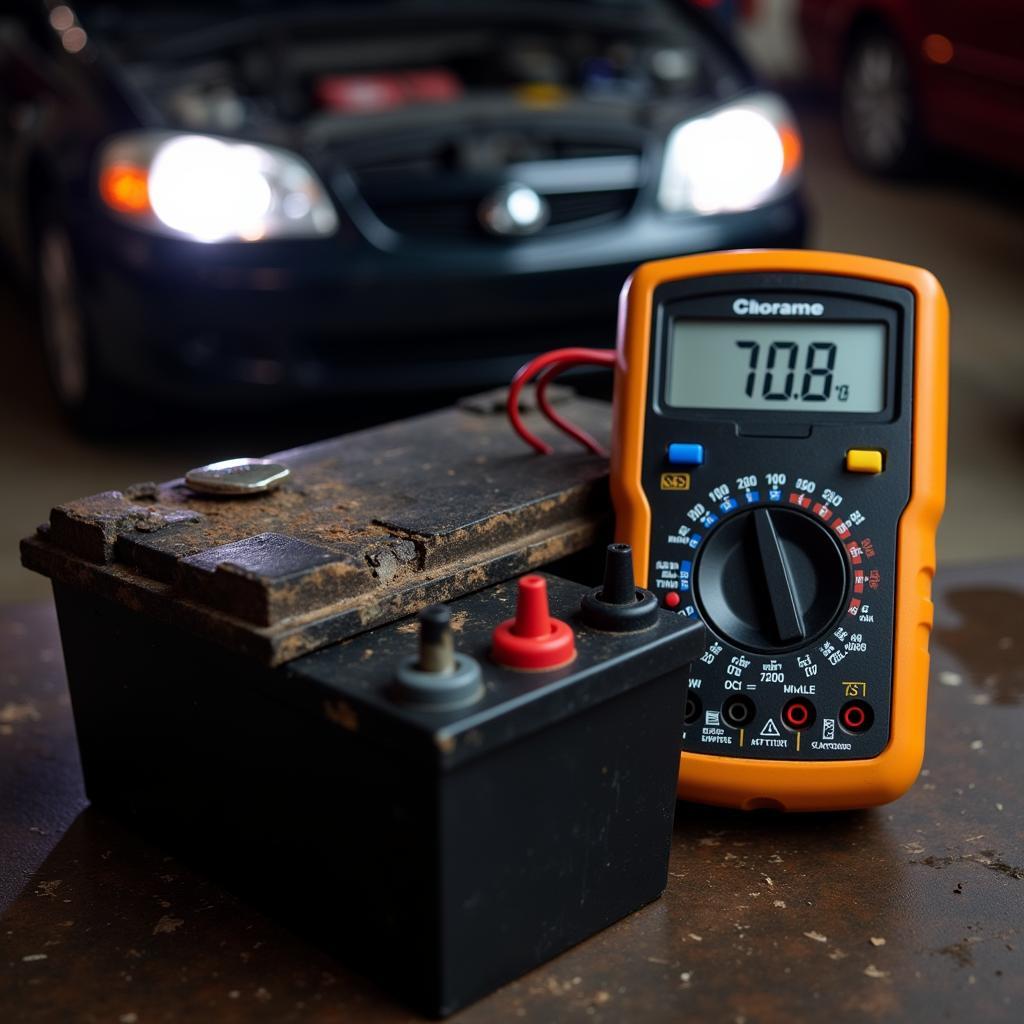A bad battery voltage can be the root of many frustrating car problems. Whether your car won’t start, the electronics are acting strangely, or you’re experiencing dimming headlights, understanding the causes and solutions for bad battery voltage is crucial. This guide will delve into the common causes, symptoms, diagnostic procedures, and solutions for dealing with a car exhibiting bad battery voltage.
Diagnosing a bad battery can be a headache, but with the right tools and information, you can tackle the issue head-on. Firstly, remember that a fully charged car battery should read around 12.6 volts. A reading significantly lower than this indicates a problem. Common causes include a failing alternator, parasitic drain, corroded battery terminals, or simply an old battery that’s reached the end of its life.
Identifying Symptoms of Bad Battery Voltage
Recognizing the signs of bad battery voltage can save you time and money down the road. Some common symptoms include:
- Slow Cranking: If your car turns over slowly but wont start, it could be a sign of low battery voltage.
- Dim Headlights: Headlights that dim, especially when other electrical components are in use, indicate a voltage issue.
- Malfunctioning Electronics: Erratic behavior of electronic accessories, such as the radio, power windows, or interior lights, can point to a bad battery voltage.
- Dashboard Warning Lights: Check engine light or battery light illumination can signal a charging system problem, possibly related to battery voltage.
- Clicking Sound When Starting: A rapid clicking sound when you turn the key indicates insufficient voltage to engage the starter motor.
 Car Battery Showing Low Voltage Symptoms
Car Battery Showing Low Voltage Symptoms
Diagnosing Bad Battery Voltage
To properly diagnose the issue, you’ll need a multimeter. Here’s a step-by-step guide on how to test your car battery voltage:
- Turn off all electrical accessories in your car.
- Set your multimeter to the DC voltage setting.
- Connect the red lead of the multimeter to the positive (+) terminal of the battery.
- Connect the black lead of the multimeter to the negative (-) terminal of the battery.
- Observe the reading on the multimeter.
If the reading is significantly lower than 12.6 volts, it indicates a problem with your battery or charging system. diagnosing a bad battery provides more in-depth information on this process.
Solving Bad Battery Voltage Issues
Once you’ve diagnosed the problem, you can take appropriate steps to fix it. Here are some potential solutions:
- Jump Starting the Car: If your car battery got discharged, jump-starting can get you back on the road. However, it’s essential to address the underlying cause of the discharge to prevent it from happening again. You can find more information on this at car battery got discharged.
- Cleaning Battery Terminals: Corroded terminals can impede the flow of current. Cleaning them with a wire brush and baking soda solution can often restore proper voltage.
- Replacing the Battery: If your battery is old or damaged, replacement is the best option. Modern batteries typically last 3-5 years.
- Checking the Alternator: A faulty alternator will not charge the battery properly, leading to low voltage. Testing the alternator’s output voltage is necessary to determine if it needs replacement. Problems with 12-volt batteries, in particular, can often be traced back to a faulty alternator. More information can be found at 12 volt battery problems.
Common Questions About Bad Battery Voltage in Cars
What is the ideal car battery voltage? A fully charged car battery should read around 12.6 volts.
Can low battery voltage damage electronics? Yes, prolonged low voltage can damage sensitive electronic components.
How often should I test my car battery voltage? It’s a good practice to test your battery voltage every few months.
Can I drive with a bad battery voltage? You can drive for a short distance, but it’s crucial to address the issue as soon as possible.
How do I prevent bad battery voltage? Regular maintenance, such as cleaning terminals and ensuring the charging system works correctly, can prevent voltage issues.
What causes parasitic drain? A parasitic drain occurs when an electrical component continues to draw power even when the car is off. Common culprits include faulty interior lights, glove compartment lights, or aftermarket accessories.
Is there a specific battery problem for certain car models like the 2014 Buick LaCrosse? While certain car models can have specific issues, bad battery voltage is a general problem that can affect any vehicle. For more specific information on a particular model like the 2014 Buick LaCrosse, you might find resources like 2014 buick lacrosse battery problems helpful.
Conclusion
Bad battery voltage in a car can be a nuisance, but understanding its causes, symptoms, and solutions empowers you to take control. By following the diagnostic steps and implementing the appropriate fixes, you can ensure your car starts reliably and runs smoothly. Remember, addressing the issue promptly can prevent further damage and save you money in the long run. Don’t hesitate to consult a professional mechanic if you’re unsure about any aspect of diagnosing or fixing a bad battery voltage problem.

